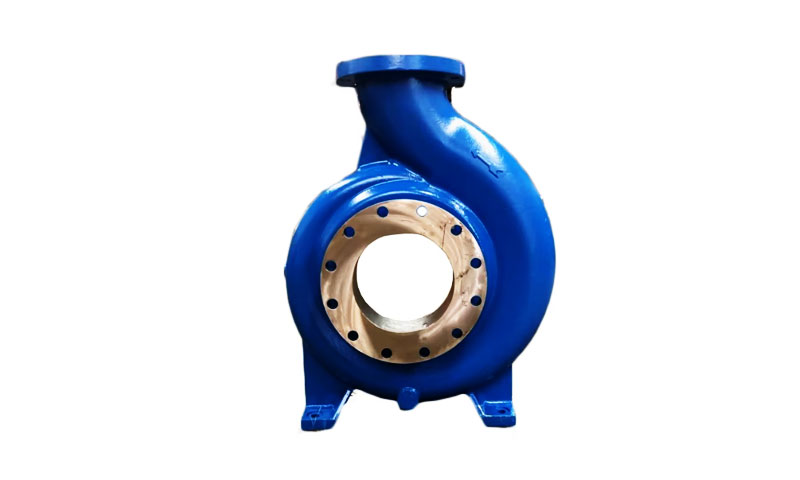1. Introduzione
Pump bodies are structural and hydraulic housings that convert driver energy into fluid motion. They commonly contain volutes, impeller seats, bearing bosses, flanges and internal passages.
The manufacturing route chosen for a pump body sets achievable geometry, metallurgia, cost and lead time.
Investment casting stands out where geometry is complex (internal guide vanes, thin webs, integrated bosses), tolerances are tight, and high-integrity alloys (acciai inossidabile, leghe di nichel, Bronzi) sono richiesti.
2. What Is an Investment Casting Pump Body?
Definition and core functionality
UN Casting per investimenti pump body is a pump housing produced by the lost-wax (investimento) Metodo di casting.
A wax (o polimero) pattern of the pump body is created, coated in refractory ceramic to build a shell, the wax removed by heating, and molten metal poured into the ceramic mold.
The fired shell is broken away after solidification to reveal a near-net cast pump body that is subsequently finished and inspected.
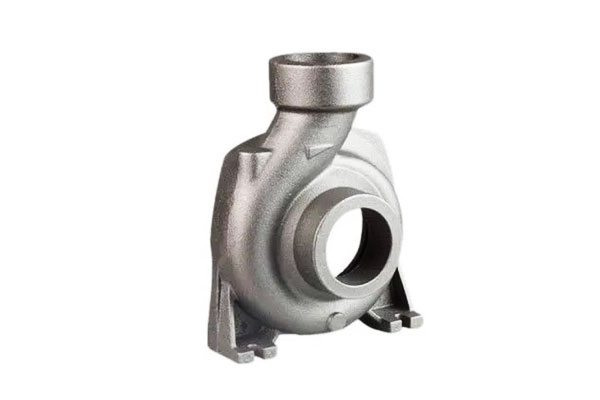
Typical specifications and dimensions
- Part mass: investment cast pump bodies usually range from a few hundred grams to tens of kilograms per piece; many foundries routinely cast pump bodies from ~0.5 kg up to ~50–100 kg depending on plant capability.
- Spessore del muro: typical nominal walls for stainless or nickel alloys: 3–12 mm; minimum thin sections down to 1–2 mm are achievable in selected alloys and process control.
- Tolleranza dimensionale (as-cast): general investment cast tolerances commonly fall in ± 0,1-0,5 mm for small features; percent-based tolerance of ±0.25–0.5% linear is a practical rule of thumb.
Critical machined features are usually left with machining allowance (0.2–2.0 mm depending on casting accuracy). - Finitura superficiale (as-cast): typical Ra 1.6–3,2 μm (50–125 min) for standard ceramic shells; fine shells and careful pouring can produce Ra ≈ 0.8–1.6 μm.
Sealing faces or bearing journals are machined/lapped to much finer Ra (≤ 0.2 μm) as required.
3. Considerazioni di progettazione
Investment casting enables complex geometry, but good design practice maximizes quality and minimizes cost.
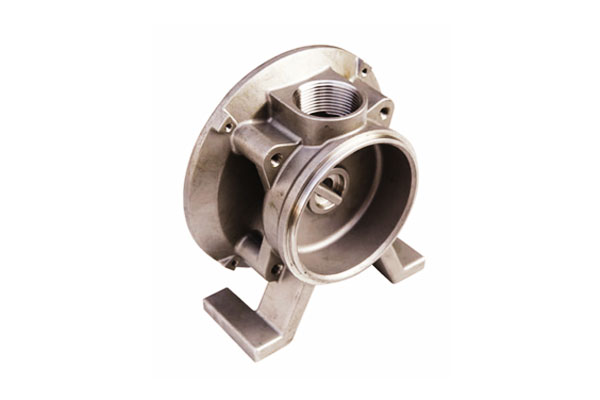
Hydraulic performance requirements
- Flow passages & volutes: smooth fillets and controlled convergence avoid separation and cavitation.
Internal fillet radii should be generous (≥ 1–2× wall thickness) to reduce turbulence. - Impeller seat alignment: concentricity and perpendicularity are critical — plan for machined bores and datum features.
- Clearances: pump clearances at impeller overhangs and seal faces must be maintainable by post-cast machining.
Structural requirements
- Stress & fatica: consider cyclical loads; use finite-element analysis to identify local stress risers.
Cast metallurgy (dimensione del grano, segregazione) affects fatigue life—design to avoid thin, highly stressed bosses without proper filleting. - Vibration: stiff webs and ribs help raise natural frequencies; investment casting allows ribs to be integrated into the body.
Corrosione & Indossare
- Selezione del materiale: choose alloy based on fluid chemistry (ph, cloruri, particolati erosivi, temperatura).
For seawater, duplex or cupronickel may be required; for acids, Hastelloy or appropriate nickel alloys. - Erosion resistance: smooth internal surfaces and sacrificial coatings (facce, spray termico) are options where particulate slurry is present.
Tolleranze dimensionali & finitura superficiale
- Caratteristiche critiche: designate which faces/bores are finish-machined and specify machining allowances (PER ESEMPIO., 0.5–1.5 mm for sandier shells, 0.2–0.6 mm for precision shells).
- Sealing surfaces: specify Ra and flatness; often lapped/polished to Ra ≤ 0.2 μm and flatness within 0.01–0,05 mm depending on pressure class.
4. Materials for Investment Casting Pump Bodies
Material selection is a critical factor in designing and producing investment-cast pump bodies, as it directly affects mechanical performance, Resistenza alla corrosione, produzione, e vita di servizio.
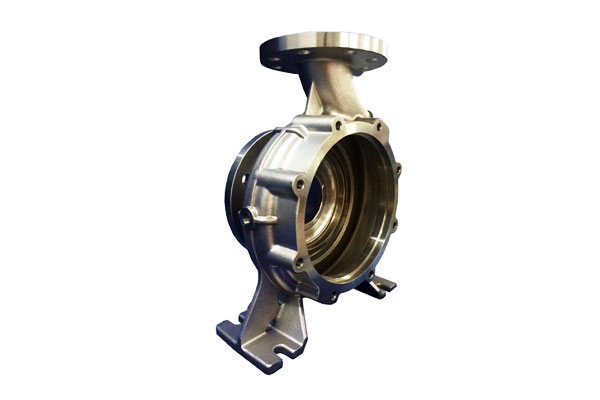
| Categoria materiale | Leghe di esempio | Proprietà chiave | Applicazioni tipiche | Considerazioni sul casting |
| Austenitico Acciaio inossidabile | 304, 316L | Eccellente resistenza alla corrosione, forza moderata, Buona saldabilità; Trazione: 480–620 MPA, Prodotto: 170–300 MPA, Allungamento: 40–60% | General chemical pumps, Trattamento delle acque, cibo & bevanda | Good molten fluidity, low hot-cracking risk, easy post-machining |
| Acciaio inossidabile duplex | 2205, 2507 | Alta resistenza (Yield 450–550 MPa), superior chloride stress corrosion resistance | Marine and offshore pumps, ambienti chimici aggressivi | Requires controlled temperature; post-casting heat treatment to prevent sigma phase |
Leghe di nichel |
Incontro 625, 718; Hastelloy | Eccezionale resistenza alla corrosione, resistenza ad alta temperatura, Resistenza all'ossidazione | Elaborazione chimica, generazione di energia, olio & gas | High melting points (≈1450–1600 °C); careful mold preheating and controlled pouring needed; difficult machining |
| Bronzo and Copper Alloys | C93200, C95400 | Eccellente resistenza alla corrosione dell'acqua di mare, Buona resistenza all'usura, antifouling; inferiore resistenza meccanica | Pompe marine, raffreddamento dell'acqua di mare, Componenti idraulici | Lower melting points (≈1050–1150 °C) simplify casting; low thermal cracking risk; mechanical strength lower than stainless/nickel |
5. Investment Casting Process for Pump Bodies
Colata di investimento, noto anche come Casting di cera perduto, enables the production of pump bodies with complex geometries, pareti sottili, e precisione ad alta dimensione.
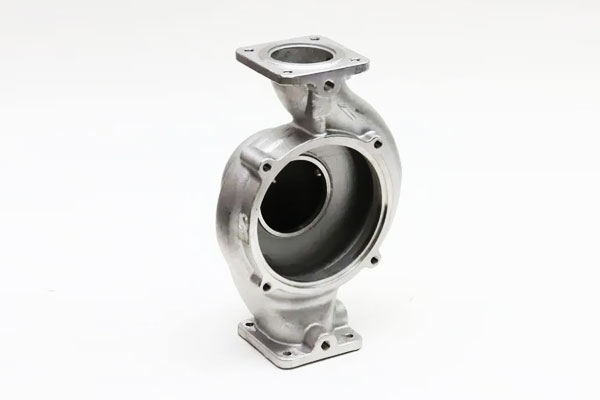
The process consists of several critical steps:
| Fare un passo | Descrizione | Considerazioni chiave |
| 1. Creazione di pattern di cera | Molten wax is injected into precision molds to form replicas of the pump body. | Ensure uniform wall thickness; maintain dimensional accuracy ±0.1 mm; use high-quality wax to prevent distortion. |
| 2. Assembly of Wax Tree | Individual wax patterns are attached to a central wax sprue to form a tree for batch casting. | Sprue design affects metal flow; minimize turbulence during pouring. |
| 3. Edificio a conchiglia in ceramica | Repeated dipping in ceramic slurry and stuccoing with fine refractory sand creates a strong, Shell resistente al calore. | Target shell thickness (5–10 mm) depends on pump body size; avoid cracks and porosity in the shell. |
| 4. Dewaxing and Mold Firing | Wax is melted out (autoclave or kiln), lasciando una cavità; the ceramic shell is then fired to remove residues and strengthen the mold. | Temperature ramping must be controlled to prevent shell cracking; residual wax must be fully removed. |
5. Colata di metallo |
Metallo fuso (acciaio inossidabile, nickel alloy, o bronzo) is poured into the preheated ceramic mold under gravity or vacuum-assisted conditions. | Pouring temperature and rate must ensure complete filling; control turbulence and prevent oxide formation. |
| 6. Solidificazione e raffreddamento | Metal solidifies inside the mold; cooling rates affect microstructure, Proprietà meccaniche, e stress residuo. | Thick sections may require controlled cooling to prevent porosity; thin walls must avoid hot tearing. |
| 7. Rimozione del guscio | Ceramic shell is broken away mechanically, often using vibration, sand blasting, or chemical dissolution. | Avoid damaging intricate pump channels or flanges. |
| 8. Finishing and Cleaning | Residual ceramic, gating system, and surface imperfections are removed via grinding, Scatto, or chemical cleaning. | Maintain dimensional tolerances; prepare surfaces for subsequent machining or coating. |
6. Operazioni di post-casting
After the pump body is removed from the ceramic shell, several post-casting operations are performed to ensure the component meets functional, dimensionale, e requisiti di qualità della superficie.
These operations are critical for high-performance applications in chemical, marino, e settori industriali.
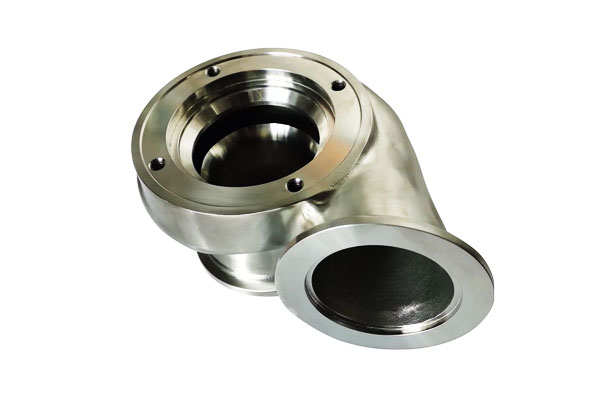
Trattamento termico
Trattamento termico is applied to relieve residual stresses, migliorare la duttilità, and optimize mechanical properties:
- Ricorrezione di sollievo dallo stress: Heating to 550–650 °C for stainless steels reduces residual stress from casting and prevents distortion during machining.
- Soluzioni ricottura: Applied for stainless steels and nickel alloys to homogenize microstructure and dissolve unwanted precipitates, ensuring corrosion resistance and consistent hardness.
- Aging or Precipitation Hardening (for certain alloys): Enhances strength and wear resistance in high-performance materials.
Lavorazione
Critical dimensions such as flanges, Bores, mating surfaces, and threaded ports are machined to meet tight tolerances.
Typical machining operations include turning, fresatura, perforazione, and boring. Machining ensures:
- Dimensional tolerances of ±0.05–0.1 mm for precise assembly.
- Smooth sealing surfaces to prevent leaks in high-pressure applications.
Finitura superficiale
Finitura superficiale Migliora la resistenza alla corrosione, resistenza all'usura, ed estetica:
- Lucidatura: Improves smoothness for sealing faces and internal channels.
- Scatto: Removes residual ceramic particles and creates a uniform surface for coating or painting.
- Rivestimenti: Optional chemical or electroplated coatings (PER ESEMPIO., nichel, Ptfe) enhance corrosion resistance and reduce friction.
Test non distruttivi (Ndt)
To detect defects such as porosity, crepe, or inclusions, NDT is performed:
- Radiografia (Radiografia): Identifies internal voids and inclusions.
- Test ad ultrasuoni (Ut): Detects subsurface flaws in thick sections.
- Test del penetrante colorante (Pt): Reveals surface cracks and porosity.
Cleaning and Inspection
Finalmente, pump bodies are cleaned to remove residual machining oils, Detriti, or salts. Dimensional and visual inspections verify compliance with specifications before assembly or shipment.
7. Quality Assurance and Testing
Garanzia di qualità (QA) is critical in ensuring that investment casting pump bodies meet design specifications, performance standards, e requisiti del settore.
A systematic QA approach combines dimensional checks, Test meccanici, and non-destructive evaluation to detect defects and confirm functional integrity.
Ispezione dimensionale
Dimensional verification ensures that the pump body conforms to design drawings and tolerances:
- Coordinare le macchine di misurazione (CMM): Measure complex geometries, Bores, Flange, and mounting surfaces with accuracy of ±0.01–0.05 mm.
- Gauge Tools: Thread gauges, plug gauges, and height gauges verify critical features quickly in production.
- Misurazione della rugosità superficiale: Confirms finishing requirements for sealing faces and internal channels (PER ESEMPIO., Ra ≤0.8 μm for hydraulic components).
Mechanical Property Verification
Mechanical testing validates that the material meets required strength, duttilità, e durezza:
- Testi di trazione: Measures yield strength, ultimate tensile strength, e allungamento, ensuring the material can withstand operational loads.
- Test di durezza: Rockwell or Vickers testing confirms that heat treatment and material processing achieved the desired hardness.
- Test di impatto (se necessario): Evaluates toughness for applications exposed to fluctuating loads or shock.
Test non distruttivi (Ndt)
NDT techniques detect hidden defects without damaging the part:
- Radiografia (X-ray/CT Scanning): Identifies internal porosity, inclusioni, and voids, particularly in thick sections.
- Test ad ultrasuoni (Ut): Detects internal cracks, vuoti, or delaminations in dense materials like stainless steel and nickel alloys.
- Test del penetrante colorante (Pt): Reveals surface cracks, Pinchi, or fine porosity not visible to the naked eye.
- Test di particelle magnetiche (Mt): Applied for ferromagnetic alloys to detect surface and near-surface discontinuities.
Common Casting Defects and Mitigation Strategies
- Porosità: Minimized through proper gating, sfogo, and controlled solidification rates.
- Cavità di restringimento: Addressed via riser design and thermal management.
- Freddo si chiude e misrun: Avoided by maintaining optimal pouring temperatures and smooth flow in complex geometries.
- Surface Inclusions: Controlled by using high-purity alloys and proper degassing techniques.
8. Advantages of Investment Casting for Pump Bodies
- Geometria complessa: passaggi interni, thin walls and integrated bosses with minimal secondary assembly.
- Forma vicina: reduces material removal vs. rough machining from bar or billet — often 30–70% less machining per parti complesse.
- Precisione ad alta dimensione & finitura superficiale: less secondary finishing for many features compared with sand casting.
- Alloy flexibility: cast many stainless and nickel alloys with good metallurgical integrity.
- Small to medium production flexibility: tooling for wax patterns is relatively inexpensive vs. large die tooling, enabling economic runs from prototypes to thousands of parts.
9. Limitazioni e sfide
- Cost for very large parts: above certain sizes (Spesso >100 kg) investment casting becomes uneconomical compared with sand casting or fabricating/ welding.
- Tempi di consegna: pattern tooling, shell building and firing add lead time—prototype timelines usually measured in weeks.
- Porosity risk in thick sections: thick bosses or large cross-sections require careful gating, chills or segmenting to avoid shrinkage.
- Surface finish and tolerances depend on shell system: achieving ultra-fine finishes or extremely tight as-cast tolerances requires premium ceramic systems and process control.
10. Applicazioni industriali
Investment casting pump bodies are used across a broad spectrum of industries due to their complex geometry capabilities, versatilità materiale, e precisione ad alta dimensione.
The process allows engineers to design optimized hydraulic passages, pareti sottili, and integrated mounting features that improve pump efficiency and longevity.
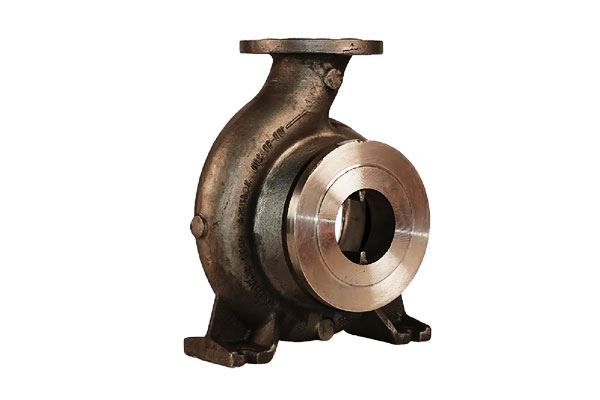
Chemical Processing Pumps
- Ambiente: Corrosive fluids such as acids, caustics, e solventi.
- Materials Used: Acciai inossidabile (316L, duplex) and nickel alloys (Hastelloy, Incontro).
- Razionale: Investment casting enables intricate internal channels, minimizing turbulence and ensuring uniform flow, critical for chemical process reliability.
Water and Wastewater Pumps
- Ambiente: High-volume pumping, abrasive suspended solids, and variable pH levels.
- Materials Used: Bronzo, acciaio inossidabile duplex, and corrosion-resistant cast irons.
- Razionale: Thin-wall, smooth internal passages reduce clogging and energy losses, improving efficiency in municipal and industrial water systems.
Marine and Offshore Pumps
- Ambiente: Saltwater exposure, high-pressure operation, and cyclical mechanical stress.
- Materials Used: Leghe di rame (ottone navale, bronzo), Acciadi inossidabile duplex.
- Razionale: Resistance to corrosion and biofouling is critical; investment casting allows seamless, complex geometries to reduce maintenance and improve service life.
Olio & Gas and Power Generation Pumps
- Ambiente: Alta temperatura, high-pressure fluids, and hydrocarbon-based media.
- Materials Used: High-nickel alloys (Incontro, Hastelloy), acciaio inossidabile, and cobalt-based alloys.
- Razionale: Investment casting supports high-strength materials and precise tolerances necessary for critical applications such as turbine lubrication, chemical injection, and offshore drilling.
Specialty and Custom Pumps
- Ambiente: Laboratory, farmaceutico, or food processing applications requiring hygienic and precision performance.
- Materials Used: Acciaio inossidabile (304, 316L), titanio, o leghe di nichel.
- Razionale: Superfici lisce, tolleranze strette, and complex geometries achieved by investment casting ensure minimal contamination risk and compliance with regulatory standards.
11. Analisi comparativa
| Caratteristica / Criteri | Colata di investimento | Casting di sabbia | Machining from Solid |
| Complessità geometrica | Excellent – thin walls, canali interni, intricate features achievable | Moderate – limited by core placement and mold stability | Limited – complex internal geometries often impossible without assembly |
| Precisione dimensionale | High – ±0.1–0.25 mm typical | Moderate – ±0.5–1.0 mm | Very High – ±0.05 mm achievable |
| Finitura superficiale (Ra) | Fine – 1.6–3.2 μm typical; can be polished | Rough – 6–12 μm; requires machining for precision | Excellent – 0.8–1.6 μm achievable with finishing |
| Opzioni materiali | Wide – stainless steels, leghe di nichel, bronzo, leghe di rame | Wide – iron, acciaio, bronzo, alluminio | Wide – depends on machinable stock availability |
| Dimensione batch | Low-to-medium – 1–1000+ parts | Medium-to-high – economical for large, parti semplici | Low – material waste increases cost for large parts |
| Tempi di consegna | Moderate – wax pattern & shell building required | Short-to-moderate – mold preparation relatively quick | Variable – depends on machining complexity |
Spreco di materiale |
Low – near-net shape reduces scrap | Moderate – gating and risers generate some waste | High – subtractive process creates chips and offcuts |
| Costo per parte | Moderate-to-high – tooling and process steps increase cost, economical for complex parts | Low-to-moderate – simpler molds, larger parts cheaper | High – extensive machining on large, complex parts is expensive |
| Forza & Integrità | Excellent – dense microstructure, minimal porosity if controlled | Moderate – risk of sand-related inclusions and porosity | Excellent – homogeneous, Nessun difetto di fusione |
| Post-Processing Required | Often minimal – some machining, finitura | Usually significant – machining and finishing required | Minimal – final finishing for tight tolerances only |
| Applicazioni tipiche | Pump bodies with thin walls, complex hydraulic channels, Resistenza alla corrosione | Grande, simple pump housings or structural components | Custom or prototype pump bodies requiring extreme precision |
12. Conclusione
Investment casting pump body combines design freedom with metallurgical integrity, making them an excellent choice for many fluid-handling applications—especially where complex internal geometry, exotic alloys or tight tolerances are required.
Success depends on early design for casting, informed material selection, careful process control (versare, shelling, Trattamento termico), and robust QA/NDT programs.
For critical pump systems—marine, chemical or power generation—investment casting can deliver reliable, economical components when specified and executed correctly.
FAQ
What maximum size of pump body can be investment cast?
Typical shop practice ranges up to ~50–100 kg per part, but the practical maximum depends on foundry capability and economics.
Very large pump bodies are more often produced by sand casting or fabricating/welding.
How much machining allowance should I design into an investment casting?
Permettere 0.2–2,0 mm depending on the criticality and shell precision. Specify tighter allowances only where the foundry guarantees precision shells.
Which material is best for seawater pump bodies?
Duplex stainless steels and selected copper-nickel alloys are common choices due to superior chloride pitting resistance and biofouling performance; final selection depends on temperature, velocity and erosion conditions.
What is the typical turnaround time for an investment-cast pump body?
Small production runs typically take 4–8 settimane from pattern approval to finished parts; single prototypes can be faster with 3D-printed patterns but still require shell firing and melt schedules.
How do I specify acceptance criteria for porosity?
Use industry NDT standards (radiografia, Ct, Ut) and define acceptance levels in percent porosity by volume or via reference images.
Critical pressure-retaining pump bodies often require porosity <0.5% by volume and radiographic acceptance per customer standard.
